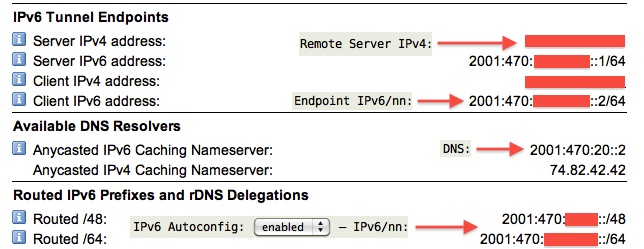IPv6 Tunnel Configuration
Requirements:
- AstLinux 0.7.4 or later
- Static IPv4 public address
- Hurricane Electric www.tunnelbroker.net account (free)*
* Note that other IPv6 Tunnel Brokers exist, and possibly may better suit your location. This example will use tunnelbroker.net.
Before creating your www.tunnelbroker.net account, be sure IPv4 ICMP is enabled in the Firewall sub-tab:

For reference, a YouTube screen-cast steps you through the process, around 2:10 into the video the nitty gritty begins, “Create Regular Tunnel”.
Tunnelbroker.net Tour & Tunnel Creation
http://www.youtube.com/watch?v=A1azHWSv2ok
After you have successfully registered with tunnelbroker.net and completed “Create Regular Tunnel”, your IPv6 tunnel configuration is shown in the format below. The labels are the AstLinux web interface Network Tab fields that are associated with the configuration values.

By default you are assigned a Routed /64 prefix. If you only have one local network, that is enough. On the other hand if you have multiple local networks and you desire a /64 for IPv6 Autoconfig for each network, you will want to enable a Routed /48 prefix (if available). A Routed /48 prefix will allow you to define up to 65,536 local /64 networks.
Select the Network Tab in the web interface. 
Note: In this example, Red fields are to be defined using your custom IPv6 Tunnel settings. Blue fields are required, but are not effected by enabling IPv6.
First select the IP Version: → “IPv4 & IPv6”
Add the “Anycasted IPv6 Caching Nameserver” to the DNS: field, also keeping your previous IPv4 DNS nameservers.

Set IPv6 Autoconfig: → “enabled” for the desired local interface.
Define your local IPv6 address for the interface in the IPv6/nn: field. Either use your given Routed /64 prefix followed by a “1” address, or define your own /64 address from your Routed /48 prefix. In either case, your address should be of the form:
2001:470:xxxx:xxxx::1/64
IPv6 Address Reference: http://en.wikipedia.org/wiki/IPv6_address

Define the IPv6 Tunnel Type: → “6in4-static” and enter the “Server IPv4 address” in Remote Server IPv4: and “Client IPv6 address” in Endpoint IPv6/nn: exactly as defined in your tunnelbroker.net account.

Finally, save settings and then reboot the system.

After the reboot is completed, test with:
$ ping6 ipv6.google.com
In a browser, http://test-ipv6.com should result in a 10/10 report.
You now (hopefully) have IPv6 connectivity!